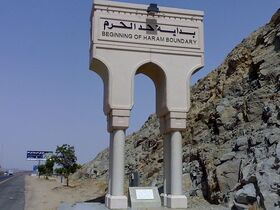Tan'im

Tanʿīm (Arabic: تَنْعیم) is a miqat or station in al-'Umra al-Mufrada. In the Battle of Karbala, it was in this station that Imam al-Husayn (a) met a caravan belonging to Yazid b. Mu'awiya which was moving from Yemen to Syria and rented their camels.
Location
It is a region on the northwestern side of Masjid al-Haram between Mecca and Sarif. It is located between two mountains, Na'im (نَعیم) and Nāʿim (ناعِم). It is also known as "Nu'man" (نُعْمان). It is two parasangs away from Mecca.[1]
Miqat
Tan'im is considered as "adna l-hill" (that is, the closest place to the limits of haram) and it is one of the miqats (stations) of al-'Umra al-Mufrada.[2] The Prophet Muhammad (s) ordered 'Abd al-Rahman b. Abi Bakr to take 'A'isha to this place so that she wears the ihram of al-'Umra al-Mufrada.

Masjid al-Tan'im is located in this area. The mosque used to be known as the "Mosque of 'A'isha" as well.[4] Today, the mosque is located inside the city of Mecca, and the indicators of the limits of haram are installed around it.
Events
Upon his return from Mi'raj, the Prophet (s) met a commercial caravan of the Quraysh in this place. When polytheists of the Quraysh denied his claims of Mi'raj, he appealed to his meeting with this caravan to support his claim.[5]
In the third[6] or fourth[7] year after Hijra (625 or 626), Khubayb b. 'Adi and Zayd b. Dathina al-Ansari were martyred in this place.
After leaving Mecca in 60/680, Imam al-Husayn (a) met a caravan in Tan'im; the caravan was taking some possessions for Yazid b. Mu'awiya to Syria from Yemen. According to al-Shaykh al-Mufid's al-Irshad, when Imam al-Husayn (a) met the caravan, he rented their camels. He offered the owners of the camels to go to Iraq with him and then receive their full rent, or receive part of their rents for the path they had traveled. Then the Imam (a) went on his way to Sifah.[8] However, some Sunni historical sources have claimed that Imam al-Husayn (a) confiscated the possessions of the caravan.[9]
Notes
- ↑ Yaqūt al-Ḥamawī, Muʿjam al-buldān, vol. 2, p. 49.
- ↑ Khomeini, Taḥrīr al-wasīla, vol. 1, p. 411.
- ↑ Ḥurr al-ʿĀmilī, Wasāʾil al-Shīʿa, vol. 8, p. 153.
- ↑ Yaqūt al-Ḥamawī, Muʿjam al-buldān, vol. 2, p. 49.
- ↑ Ibn Athīr, al-Kāmil, vol. 2, p. 56.
- ↑ Khalīfat b. Khayyāṭ, Tārīkh al-Khalīfa, p. 32.
- ↑ Ṭabarī, Tārīkh al-umam wa l-mulūk, vol. 2, p. 538-542.
- ↑ Mufīd, al-Irshād, vol. 2, p. 68.
- ↑ Ibn Athīr, al-Kāmil, vol. 4, p. 40.
References
- Ḥurr al-ʿĀmilī, Muḥammad b. al-Ḥasan al-. Wasāʾil al-Shīʿa. Qom: Muʾassisat Āl al-Bayt, 1409 AH.
- Ibn Athīr, ʿAlī b. Abī l-Karam. Al-Kāmil fī l-tārīkh. Beirut: Dār al-Ṣādir, 1385 AH.
- Khalīfat b. Khayyāṭ. Tārīkh al-Khalīfa. Edited by Fawāz. Beirut: Dār al-Kutub al-ʿIlmīyya, 1415 AH.
- Khomeini, Sayyid Rūḥollāh. Taḥrīr al-wasīla. Qom: Dār al-ʿIlm, 1379 Sh.
- Mufīd, Muḥammad b. Muḥammad al-. Al-Irshād fī maʿrifat ḥujaj Allāh ʿalā l-ʿibād. Qom: Kungira-yi Shaykh al-Mufīd, 1413 AH.
- Ṭabarī, Muḥammad b. Jarīr al-. Tārīkh al-umam wa l-mulūk. Edited by Muḥammad Abū l-Faḍl Ibrāhīm. Beirut: Dār al-Turāth, 1387 AH.
- Yaqūt al-Ḥamawī. Muʿjam al-buldān. Beirut: Dār al-Ṣādir, 1995.

